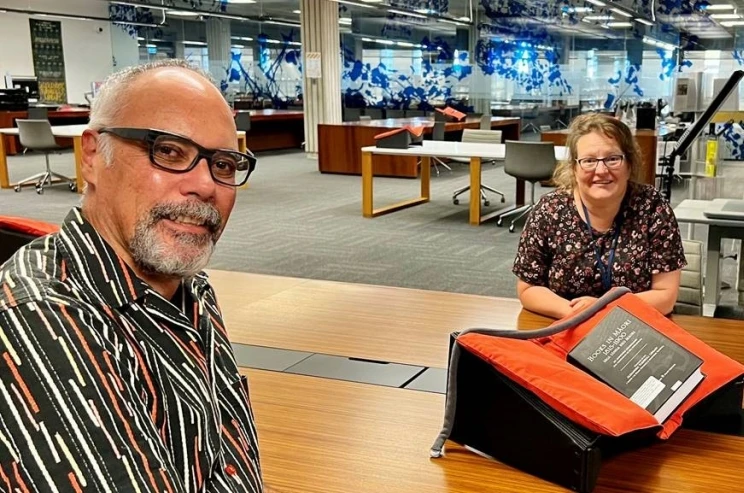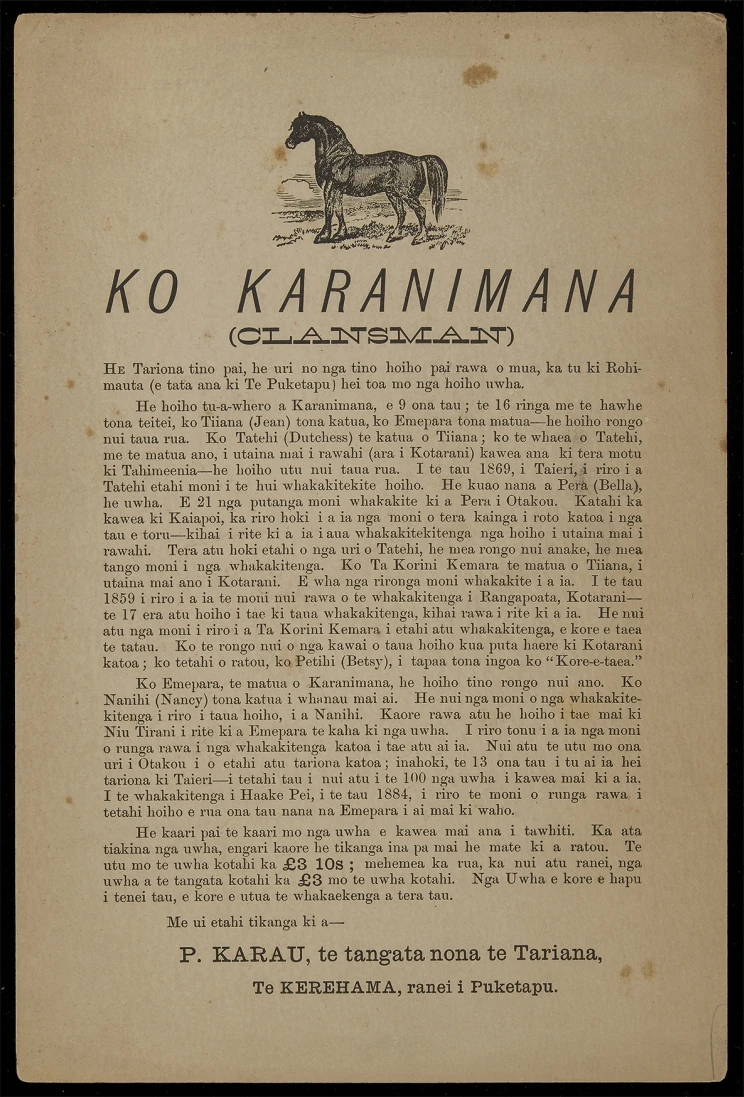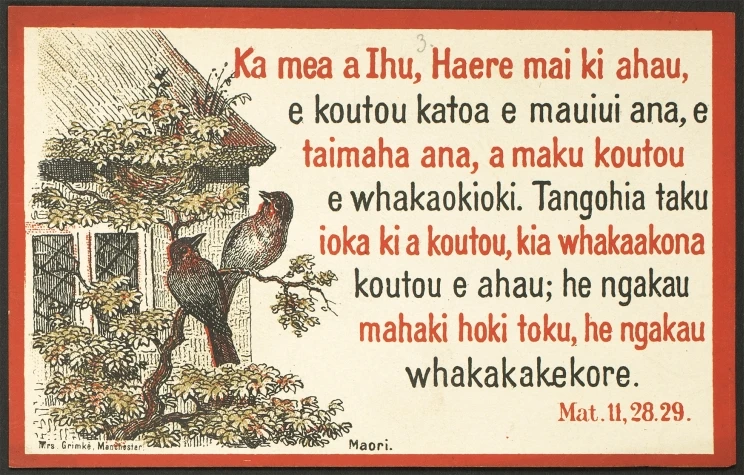Off the record | Preserving te reo print
From newspapers to a booklet on bee-keeping, precious printed materials in te reo Māori are being digitised. Paul Diamond, Curator, Māori, talks to Melanie Lovell-Smith about the mahi currently underway to preserve nineteenth century Māori texts.
Digital preservation of printed te reo Māori
Tēnā koutou. I'm a Digitisation Advisor at the National Library, and I have been in this role for five years. There are two teams digitising material at the National Library: the Image Services team, who digitise collection items such as the artworks, photographs and cartoons you can find online, and the team I work for. We manage the bulk digitisation of newspapers and other published material. These all go onto the National Library's Papers Past website.

Paul Diamond, Curator Māori and Melanie Lovell-Smith, Digitisation Advisor. Photo by Chris Szekely.
One of the projects I am leading plans to digitise at least one copy of all the items listed in Books in Maori / Ngā Tānga Reo Māori (BIM). This is a bibliography compiled by Penny Griffith and Phil Parkinson in the Turnbull Library in 2004. The book lists all the known items printed in te reo Māori during the 19th century, from 1815 through to 1900. Once digitised, these will be made available via Papers Past, using the new Books section launched in December 2021.
Books in Māori digitisation project
The BIM digitisation project started with a pilot focused on items just held by the Turnbull. The first part of this selection (around 10% of the collection) was launched in August 2021, followed by another set in December 2021. This initial tranche included Ko te Kahiti, the largest single item on the list.
Ko te Kahiti was a te reo Māori version of the NZ Gazette, published from 1865-1931. It was produced to make official decisions relating to Māori available in te reo Māori, and it contains notices from the government, new Acts relating to Māori, and notices of hearings and reports on Native Land Court decisions. There are nearly 30,000 pages in total, mostly in te reo Māori.
We are now working on the rest of the collection, beginning with any conservation work that’s needed before the items are photographed. Heritage Studios have begun photographing the items that have been through conservation, and 20,000 plus pages of Ko te Kahiti are now with us for testing.
Another team member, Clare Butler (Ngāti Kahungunu ki Te Wairoa), is consulting with iwi, hapū and whānau, to make contact with descendants of the tūpuna who produced the works or, in some cases, who the works were about. A number of people that Clare has contacted have subsequently come into the Library, and I think she put it beautifully in a recent article:
To locate whānau of descendants is incredible and then to have them come to view the taonga whilst sharing memories and gently rubbing the signature of their grandfather, who had passed long before they were born, is a precious sight to witness.
A huge variety of material
Because BIM is a bibliography of anything that was printed in te reo, not just published, there's a huge variety of other material. Together with the more than 300 Māori language newspapers and magazines, there are 1,565 items listed, of varying length. The three biggest groups are probably religious material (Bibles and hymn books), government publications, and language tools, such as dictionaries. There are a few items that relate to agriculture and horticulture - Kō Ngā Pī, for example, an 1849 booklet by the Anglican missionary William Cotton about 'Bee-keeping and the making of honey'.
Personal favourites
Being involved in this project has given me the amazing opportunity to look at some of the earliest printings in te reo Māori, such as Thomas Kendall's A grammar and vocabulary of the language of New Zealand (1820). This is not the earliest item to be published in te reo Māori. That was A korao no New Zealand, or The New Zealander's first book, published in 1815. Only one copy is known to have survived, and it is now at Auckland Museum.
Some of my favourite items are the pieces of ephemera in this collection, such as invitations to hui, and advertisements. The advertisement below is for the stud stallion 'Ko Karanimana' (Clansman). The ephemera like this reinforces, for me, the bilingual world of 19th century New Zealand.

An advert promoting 'Ko Karanimana' or 'Clansman', giving his pedigree and costs. Publisher not named, 1887. Ref: BIM 1182. Alexander Turnbull Library.
You can also see this in early grammar books. The sample sentences below are from the back of an 1844 grammar book:
'Do you know how to sew / E matau ana koe ki te tui kakahu?"
'Mend this hole / Tuia te kore nei.'
'You must not be idle / Kei mangere koe.'
'You must work from sunrise to sunset / Me mahi koe no te putanga o te ra, a po noa.'
These were written by, and developed for, British missionaries so they could communicate with their Māori hosts. As well as reflecting the missionaries' strategies to convert Māori — and ensure their own survival in this new land — these phrases illustrate their world view, both as male missionaries and as part of the British Empire.
I was also fascinated by a set of Mrs Grimkè's 'scripture cards’, because of their iconography.
The left card below quotes Matthew 11:28, 29 beginning: 'Come unto me, all ye that labour and are heavy laden, and I will give you rest.’ The second card at right quotes John 10: 14-15: ‘I am the good shepherd... and I lay down my life for the sheep’. As well as being visually interesting with their mix of te reo Māori and English iconography, the cards have a history that ties them to the worldwide movement of Anglican evangelism.
Look out for the next instalments of material on Papers Past in 2023.
Ka mea a Ihu, haere mai ki ahua e koutou katoa e mauiui ana, e taimaha ana, a maku koutou e whakaokioko. Mathew, 11: 28-28. Manchester: Mr Grimke, 1818. Ref: BIM 995. Alexander Turnbull Library.

Ka mea a Ihu, haere mai ki ahua e koutou katoa e mauiui ana, e taimaha ana, a maku koutou e whakaokioko. Mathew, 11: 28-28. Manchester: Mr Grimke, 1818. Ref: BIM 995. Alexander Turnbull Library.
Ka mea a Ihu, Ko ahau te hepara pai... e tauku ana ano hoki ahau i a au ki te mate mo nga hipi. Hoani 10, 14-15. Manchester: Mrs Grimke, 1881. Ref: BIM 995. Alexander Turnbull Library.

Ka mea a Ihu, Ko ahau te hepara pai... e tauku ana ano hoki ahau i a au ki te mate mo nga hipi. Hoani 10, 14-15. Manchester: Mrs Grimke, 1881. Ref: BIM 995. Alexander Turnbull Library.
Thanks to Friends of the Turnbull Library
Thanks to the Friends of the Turnbull Library for permission to republish this article, which was originally published in their Off the Record print publication.
The Friends of the Turnbull Library is a national organisation that supports the work and activities of the Alexander Turnbull Library, they promote public interest in the Library’s collections and supports research and use of its collections.
More information about the Friends of the Turnbull
Our Off the record blog series will republish articles from the Off the Record magazine including stories about new acquisitions, research projects and other news about the Turnbull Library collections.